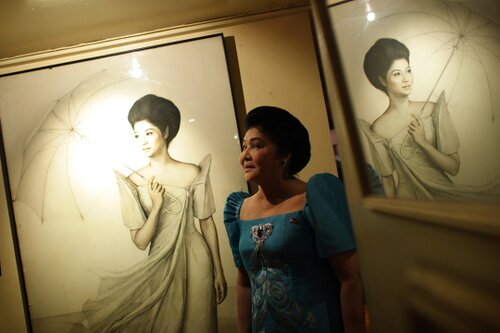Malice in Wonderland: The Imelda Marcos Story
The looking-glass world of Imelda Marcos comes under scrutiny in a documentary film.

Photo credit: Paolo Picones
It is a testament to her residual power that Imelda Marcos was able to get a court order to prevent a damning film about her to be shown in the Philippines. What other widow of a reviled dictator could get her way in the country that she pillaged?
Consider the facts. She was found guilty of corruption and sentenced to a minimum of 12 years in prison in 1993.
The Philippine Supreme Court overturned the conviction.
The Marcos estate lost a class action lawsuit for human rights violations. A US Federal District Court awarded the plaintiffs $2 billion. The money has yet to be paid.
In 2003, the Philippine Supreme Court upheld a lower court ruling that found Imelda Marcos guilty of funneling $659 million to private Swiss bank accounts and awarded the entire amount to the Philippine government.
Over 150 other court cases are currently pending.
And in an ironic perversion of justice, Imelda Marcos receives a monthly pension of $90 from the Philippine government as a widow of a war veteran.
Imelda insists she did not give her permission for a film about her rise from beauty queen to Philippine First Lady.
“We have to stick to the truth because truth is God,” she said. “Many things were lifted out of context and insertions there were quite, sometimes malicious.”
She said she co-operated with the film because she thought it was for a thesis. Reportedly director Ramona Diaz was given 15 minutes. This stretched to five hours of the former First Lady speaking non-stop and playing video after video of media coverage of the Marcoses.
"Imelda" was given good reviews abroad and won best cinematography at the Sundance Film Festival in the US. Eventually Mrs Marcos allowed the showing of the film on condition that the director dropped the word “documentary” from the title. "Imelda" went on to become a smash Filipino hit, beating "Spider-Man 2" in theatres.
In the movie we are shown a mythology that Imelda has carefully cultivated. In the opening sequence she presents her world view in an engaging way. Still coquettish in her mid-70s, she leafs through a book she has written called "Circles of Life". The method in her madness breaks down later in the film when she illustrates with a marker pen her philosophy complete with apples, hearts and a Pac-Man. A Jesuit priest recounts how she presented the same to him non-stop for four hours. Bernice Ocampo, her niece, laments that Imelda’s downfall was brought about by flatterers, not true friends.
Imelda’s hubris knows no bounds. In her hometown of Tacloban, she has made a shrine to herself and Jesus Christ. The chapel on the first floor is lined with dioramas of her rise from being a little girl playing in the sand to becoming a heroine of her people helping the downtrodden. Upstairs visitors are shown her ornate bedroom which has walls completely covered in woven leather strips.
Her childhood friend Lettie Loksin is filmed saying that when she first met Imelda she thought she looked like the Virgin Mary — long-haired and beautiful. Another childhood friend recalls, “Imelda’s dresses were made of parachutes and bedsheets during the war. She did not mind as long as she had a new dress.”
We get Imelda’s spin on her own vanity when she boasts that as First Lady she took an hour to dress for kings and queens but she would take "double the time" if she was going to the provinces because the people needed "a standard, a star…especially in the dark of the night".
We get Imelda’s spin on her own vanity when she boasts that as First Lady she took an hour to dress for kings and queens but she would take “double the time” if she was going to the provinces because the people needed “a standard, a star…especially in the dark of the night”.
In 1954, Imelda, met then-congressman Ferdinand Marcos in the cafeteria of the Philippine Congress and married him 11 days later. Ferdinand ran for president in 1964 and won by presenting himself and his wife as the John F Kennedys of Asia — young, fresh talent that was going to help the country advance. With the support of the US government, the Marcos’ hunger for power increased and in 1972, Ferdinand declared martial law.
This was, according to Imelda, for the good of the people. In the movie she describes the imposition of martial law in these words: “[The President] informed the family…. He called the little children together and he said the time has come [and] that what he had to offer for the survival of the country was more than life, it was honour…. because he was so democratically committed.” This is when most movie audiences laugh out loud.
Beauty vs Duty
Diaz lets Imelda do most of the talking in this film. As the powder compact-wielding maven tells us how she brought beauty to the Philippines, we get a cultural tour of Manila. Imelda, said to have an “edifice complex”, spent millions of dollars building structures for rich people in the capital city; in 1975 alone, she reportedly commissioned 14 luxury hotels, a multi-million-dollar Nutrition Center, a theatre, a convention centre, the Heart Center and the Lung Center, which did not benefit destitute Filipinos.


















